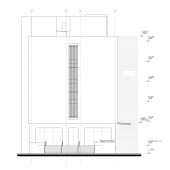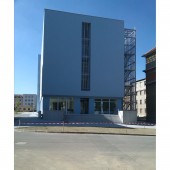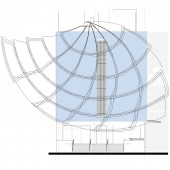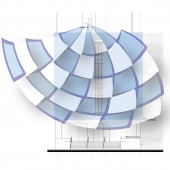
| THE AWARD |
| CATEGORIES |
| REGISTRATION |
| SUBMIT YOUR WORK |
| ENTRY INSTRUCTIONS |
| TERMS & CONDITIONS |
| PUBLICATIONS |
| DATES & FEES |
| METHODOLOGY |
| CONTACT |
| WINNERS |
| PRESS ROOM |
| GET INVOLVED |
| DESIGN PRIZE |
| DESIGN STORE |
| THE AWARD | JURY | CATEGORIES | REGISTRATION | PRESS | WINNERS | PUBLICATIONS | ENTRY INSTRUCTIONS |
Take Off Wallart by Lenka Polivkova |
Home > Winners > Design #44835 >Interview |
 |
|
FS: What is the main principle, idea and inspiration behind your design?
LP: "Sail along with ease while simultaneously experiencing the calming power of tranquillity", such was the intent behind my artistic expression.
FS: What has been your main focus in designing this work? Especially what did you want to achieve?
LP: My primary aim was to alleviate the dreary atmosphere of the given structure so that it would imbue the person looking at it with a more hopeful and uplifting feeling. My other aim was to hide the depressing façade of the building, which, on its own, is not an overly successful architectonic work, behind the picture.
FS: What are your future plans for this award winning design?
LP: I am very pleased that this piece of work will have a positive impact on the public and that people will be delighted to return to this place because they feel good and uplifted there. Winning the A’Design Award & Competition gave a huge boost to my energy and zest for getting involved in similar projects in the future.
FS: How long did it take you to design this particular concept?
LP: The task for the project was commissioned in the summer of 2015. And the final design of the work was completed within a month.
FS: Why did you design this particular concept? Was this design commissioned or did you decide to pursuit an inspiration?
LP: The investor’s expectation was not only to brighten up the dreary façade of the Psychiatric Hospital itself but also to significantly improve the overall aesthetics of the surrounding area. It was a challenge to which I responded positively because my professional focus is directed towards the creation of large-scale mural paintings. The façade of the building provided me with a large canvas, as it were, by virtue of which it was possible to realize this task. The investor fully embraced my creative idea and agreed to go ahead with the project. This then started the whole process.
FS: Is your design being produced or used by another company, or do you plan to sell or lease the production rights or do you intent to produce your work yourself?
LP: The painting itself will be done by a team of three academic painters in my presence.
FS: What made you design this particular type of work?
LP: As I said earlier, my primary professional and artistic focus is directed towards the creation of large-scale mural paintings. This challenging project, therefore, provided me with the opportunity to design my own creative response to the task set before me by the investor.
FS: Where there any other designs and/or designers that helped the influence the design of your work?
LP: The winning design is solely my own vision; the inspiration did not come from another designer, nor was it influenced by somebody else’s creative conception.
FS: Who is the target customer for his design?
LP: In the first place, the motif is specifically designed to affect positively the psychological state of the patients of the Psychiatric Hospital. However, I am certain that it will also arouse positive feelings in the general public as well as the people visiting or just passing through the area.
FS: What sets this design apart from other similar or resembling concepts?
LP: This design is a monumental mural painting which cannot be simply compared to street art. Neither is it a fortuitous ‘embellishment’ of a public open space. Despite the fact that the design is abstract, it was my intention to imbue it with the feeling of hope and lightness that would uplift this particular place and relieve its bleak atmosphere.
FS: How did you come up with the name for this design? What does it mean?
LP: "Take off" in the sense of breaking free of all that depressing stuff that holds one back and makes him or her feel miserable and despairing. That was the first thing that came to mind.
FS: Which design tools did you use when you were working on this project?
LP: An ordinary wooden pencil, a plain soft pencil eraser and, in the final stages of the work, my laptop.
FS: What is the most unique aspect of your design?
LP: This design seems timeless and supports the assertion that “beauty resides in simplicity”.
FS: Who did you collaborate with for this design? Did you work with people with technical / specialized skills?
LP: I relied on my own intuition and with respect to the technical matters, I found certain graphic computer programmes useful.
FS: Is your design influenced by data or analytical research in any way? What kind of research did you conduct for making this design?
LP: During the making of this design, I conducted no research of any kind. So my project has not been influenced by anyone or anything other than my own creativity.
FS: What are some of the challenges you faced during the design/realization of your concept?
LP: I had to deal with a very serious problem right from the beginning of the initial work on the design. The problem was that the front wall itself has its uniformity disturbed by four large oblong windows, firmly secured with bars, and placed one after the other all the way down through the middle of the building. Due to the security reasons, it was not possible to conceal them in any way. None of the subsequent designs could shake off the depressing feelings I got every time I looked at the windows. They just reminded me of a high-security prison. The solution came to my mind, however, after I had stopped seeing the disturbing windows as an obstacle. So, instead of lamenting their existence, I simply decided to incorporate them into the initial design. At once, the offending windows became the load-bearing column, the mast, to which I could secure the sails. The sails, in a total harmony with the mast, then unfurled themselves as if by magic.
FS: How did you decide to submit your design to an international design competition?
LP: The decision to enter the competition was made easier by my friends and colleagues who had repeatedly confirmed the uniqueness of my design and encouraged me to enter the competition so that it could be seen beyond the borders of the Czech Republic.
FS: What did you learn or how did you improve yourself during the designing of this work?
LP: Again, I satisfied myself that a good design emerges as soon as the designer fully understands an assignment. It is not enough that the created work looks good but that it also reflects the purpose for which it was created. To the extent that the designer adheres to this relatively simple rule and does not just try to express his or her own ego, the intuition steps in and opens the way for the right design.
FS: Thank you for providing us with this opportunity to interview you.
A' Design Award and Competitions grants rights to press members and bloggers to use parts of this interview. This interview is provided as it is; DesignPRWire and A' Design Award and Competitions cannot be held responsible for the answers given by participating designers.
| SOCIAL |
| + Add to Likes / Favorites | Send to My Email | Comment | View Press-Release |





